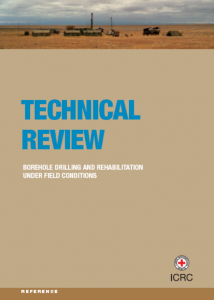This document contains a simplified design to help UNHCR and WASH actors design drilled boreholes (alluvial aquifer) in refugee settings. The package includes: Technical Drawings; Step by Step Construction Drawings; Bills of Quantity; Material and Workmanship Specifications; and Design Calculations.
Archives
D-305/2015a Post Emergency Borehole Design (Alluvial Aquifer)

D-304/2015a Post Emergency Borehole Design (Fractured Rock Aquifer)

This document contains a simplified design to help UNHCR and WASH actors design drilled boreholes (fractured rock) in refugee settings. The package includes: Technical Drawings; Step by Step Construction Drawings; Bills of Quantity; Material and Workmanship Specifications; and Design Calculations.
Practical Guidelines for Test Pumping in Water Wells (ICRC, 2011)

Pumping tests are a practical way of obtaining an idea of the borehole’s efficiency and its optimal production yield. Much of the specialized knowledge and technical expertise needed for this purpose can be gained from the standard literature. However, field operations in remote areas or in difficult conditions often require flexibility and imagination in avoiding or solving technical problems. These guidelines are intended mainly as a practical tool and
therefore contain a minimum of theory. They are aimed at water and habitat engineers working in the field who are undertaking or supervising borehole drilling or rehabilitation
programmes and are not conversant with pumping test procedures.
Borehole Drilling and Rehabilitation Under Field Conditions (ICRC, 2011)

Constructing, or repairing, boreholes requires specialized knowledge and technical expertise, much of which can be gained from the standard literature; but field operations in remote areas or in difficult conditions often require flexibility and imagination in avoiding and solving technical problems. This review is intended as a decision-making tool to assist in making cost-effective choices between borehole drilling methods, and in deciding whether to drill new boreholes or rehabilitate existing sites.
Emergency Water Sources (WEDC, 1997)

These guidelines have been designed to help those involved in the assessment of emergency water sources to collect relevant information in a systematic way, to use this information to select a source or sources and to determine the appropriate level of treatment required to make the water suitable for drinking.
- Tags: Groundwater, Groundwater, Groundwater, Groundwater, Groundwater, and Solar Pumping. Organisations: WEDC. Categories: WASH Emergency Guidelines.
DG-300 Design Guidelines for Piped Water Networks in Refugee Settings (UNHCR, 2015)

This document contains guidelines to help UNHCR and WASH actors design piped water networks in refugee settings. It describes the minimum documentation that should be included for a water network design project.
UNHCR WASH Manual – Preliminary Version (UNHCR, 2015)

The UNHCR WASH Manual is a comprehensive and authoritative reference document for WASH interventions in refugee settings, built upon the experience of UNHCR and WASH organisations.
- Tags: Bathing Facilities, Bloody Diarrhoea, Boreholes, Boreholes, Boreholes, Boreholes, Boreholes, Boreholes, Bulk Water Treatment, Bulk Water Treatment, Child Friendly Facilities, Communal Toilets, Communicable Disease Control, Community Led Total Sanitation (CLTS), Cross Cutting, Desludging and Excreta Transportation, Disability, Disease Vector Control, Drainage, Drilling, Drilling, Drilling, Drilling, Drilling, Drilling, Excreta / Urine ReUse, Excreta Composting, Excreta Management, Excreta Treatment, Gender, Grey Water Disposal, Hand Dug Wells, Hand Dug Wells, Handpumps, Handpumps, Handpumps, Handwashing with Soap, Household Toilets, Household Water Treatment, Household Water Treatment, Human Right to Water / Sanitation, Hygiene Behaviour Change, Hygiene Promotion, Landfill Management, Laundering Facilities, Malaria, Medical Waste Management, Menstruation Hygiene Management, Piped Water Networks, Piped Water Networks, Piped Water Networks, Protection, Public Health, Rainwater Harvesting, Rainwater Harvesting, Sewerage and Excreta Conveyance, Solid Waste Management, Spring Protection, Spring Protection, WASH Assessments, WASH Assessments, WASH Coordination, WASH Monitoring, WASH Monitoring, WASH Monitoring, WASH Programme Health and Safety, WASH Programme Management, WASH Programme Management, WASH Programme Management, Waste Recycling , Reuse and Reduction, Water Prospection and Investigation, Water Prospection and Investigation, Water Prospection and Investigation, Water Prospection and Investigation, Water Quality Testing and Surveillance, Water Quality Testing and Surveillance, Water Safety Plans, Water Safety Plans, Water Storage, Water Storage, Water Storage, Water Supply, Water Supply, Water Supply, Water Supply, Water Supply, Water Supply, Water Supply, Water Tankering, Water Tankering, and Watery Diarrhoea. Languages: English, English, English, English, English, and English. Organisations: UNHCR, UNHCR, UNHCR, and UNHCR. Categories: WASH Reference Documents, WASH Reference Documents, WASH Reference Documents, WASH Reference Documents, WASH Reference Documents, WASH Reference Documents, and WASH Reference Documents.
 English
English
